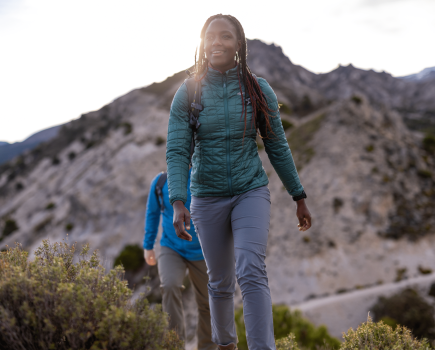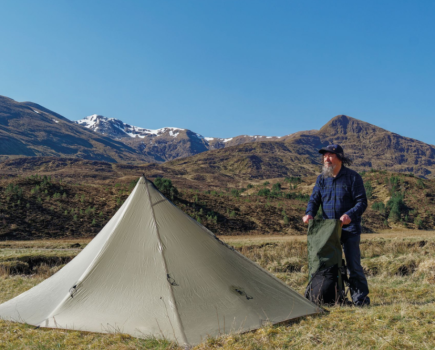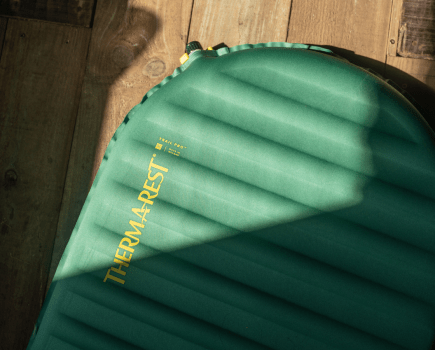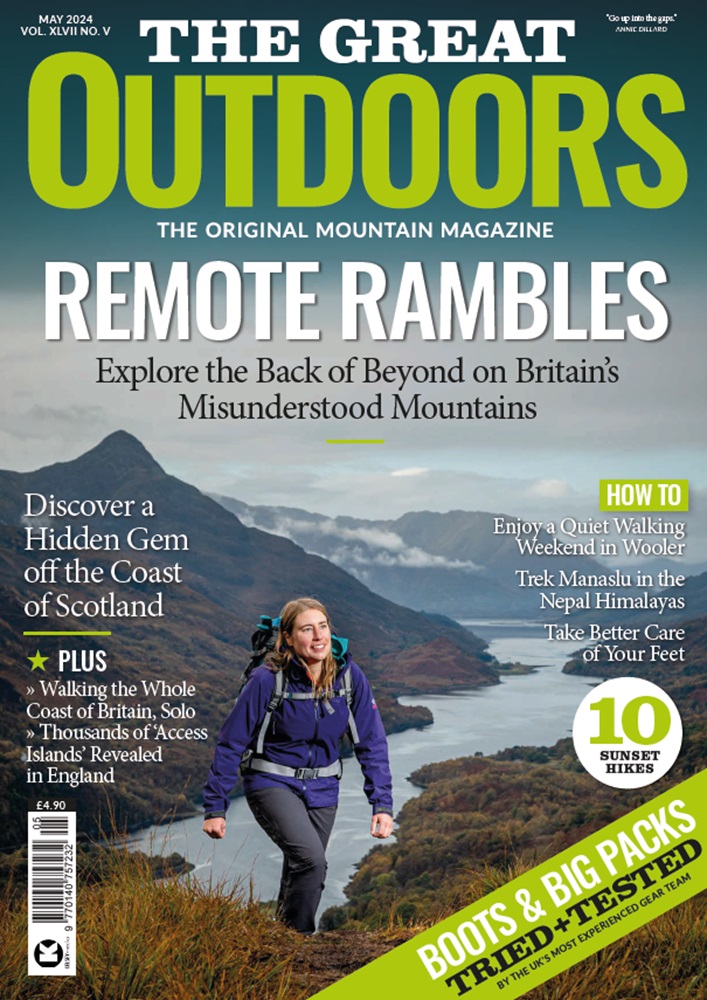When I first started hiking and backpacking, I paid little regard to nutrition – just packed whatever was cheap, calorific, and relatively lightweight. But as I’ve grown older I’ve come to realise that there’s more to it than this. Happily, there are also now far more lightweight food options available for the backpacker and hiker – and the emphasis has shifted to nutrition and high-quality ingredients.
However, weight, calorie content, and price all still matter. Dehydrated food is lightweight and packs in a lot of energy, but it can also be expensive. Alternatives worth considering include home-dehydrating your own meals or cooking from fresh ingredients in the field. Both involve a far greater degree of preparation, although foodies may consider that a plus point.
For the rest of us, the humble dehydrated backpacking meal remains a staple of our adventure larder. Just pour in boiling water, stir, wait a while, and enjoy.
In this test we’ve rounded up ten of the best meals from a broad variety of brands – including some that have not been sampled by TGO before. We’re looking at flavour, quality, cost, and ease of preparation.
Want to learn more about nutrition when hiking? Or perhaps you’re interested in some of the best best vegan and vegetarian backpacking meals.
The best backpacking meals 2024
Radix Nutrition Basil Pesto
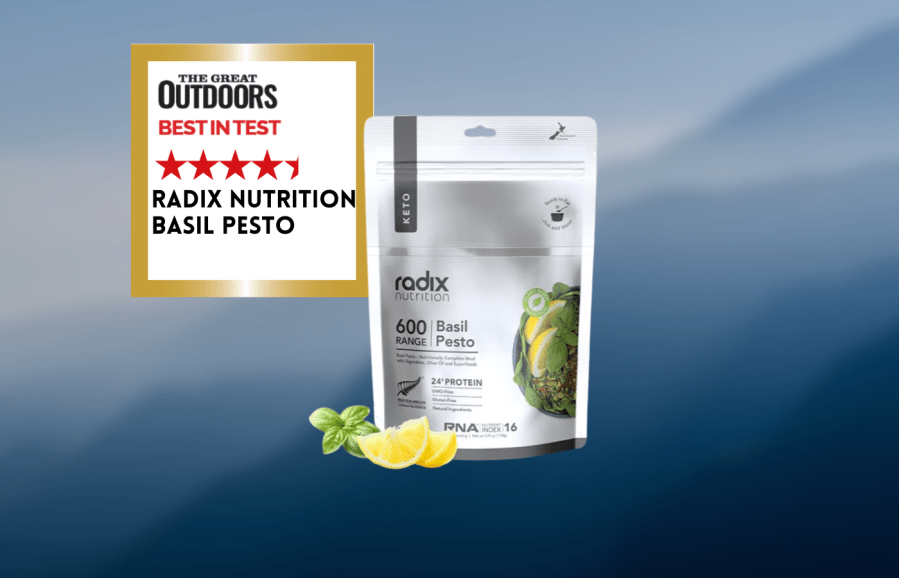
Radix, a brand focusing on nutritional quality, was a new backpacking food brand for me, and the Radix Nutrition Basil Pesto was quite a surprise. There’s a long list of ingredients on the back – but they’re all natural ingredients. Extra virgin olive oil, pumpkin seeds, millet, buckwheat, cherries, kale, baobab fruit… it’s a lot. Thankfully this results in a wonderfully varied meal with delicious, complex flavours and textures.
Alex Roddie’s Best in Test
The only reason I’m taking off half a star is the lack of fill line on the pack, which makes preparation slightly more complicated, and the fact that it took a couple of minutes longer to hydrate.- Good Value
- Quality ingredients
- Great texture and flavour
- Vitamins and minerals
- No fill line on pack
| Quick specs | |
|---|---|
| Price: £8.99 Weight: 127g Calories: 600 Calories/100g: 472.4 Calories/£1: 66.7 Time to hydrate: 7 minutes Vegan/vegetarian/dairy free/gluten free? vegetarian, dairy free, gluten free Allergens: none basecampfood.com |
I particularly liked the varied vegetables and crunchy seeds in the mix. The basil pesto came through, but was not overpowering, allowing many of the natural flavours to shine.
I was impressed by the nutritional information, which included exhaustive details of the vitamins and minerals included in the meal. This isn’t something I’ve seen from any other brand. It’s also vegetarian, dairy free and gluten free.
The only reason I’m taking off half a star is the lack of fill line on the pack, which makes preparation slightly more complicated, and the fact that it took a couple of minutes longer to hydrate than the instructions stated. Otherwise this is near perfect.
See more of Alex’s Radix Nutrition Basil Pesto Review
LYO Expedition Vegan Nettle Curry
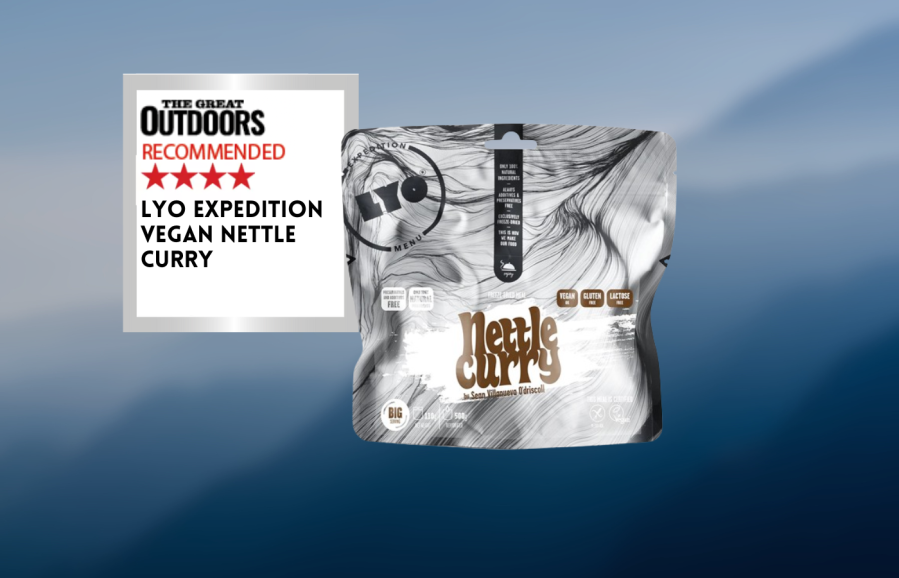
LYO Expedition make some of the most interesting and original recipes in the realms of dehydrated outdoor food – and the LYO Expedition vegan nettle curry has long been a favourite of mine. It’s a mild curry with a creamy coconut sauce (perfect for me, as I’m not a fan of overly spicy food). It has a variety of vegetables – including, yes, delicious nettle leaves. The result is tasty and with excellent texture. The rice is perfect too.
Alex Roddie Recommends
This one scores highly for ease of preparation, with two opening points (you can open it up like a bowl after hydrating) and both a fill line and a quoted fill amount in millilitres.- Delicious
- High quality ingredients
- Fewer calories than other options
- High in saturated fats
| Quick specs | |
|---|---|
| Price: £10.99 Weight: 110g Calories: 530 Calories/100g: 481.8 Calories/£1: 48.2 Time to hydrate: 9 minutes Vegan/vegetarian/dairy free/gluten free? vegan, dairy and gluten free Allergens: coconut basecampfood.com |
The only real downsides the LYO Expedition Vegan Nettle Curry is 530 Kcal is fewer than some options, and it’s relatively high in saturated fat. That’ll be the coconut.
This one scores highly for ease of preparation, with two opening points (you can open it up like a bowl after hydrating) and both a fill line and a quoted fill amount in millilitres. The pack was also easy to open.
See more in Alex’s full LYO Expedition Vegan Nettle Curry Review
Tent Meals Almond Jalfrezi
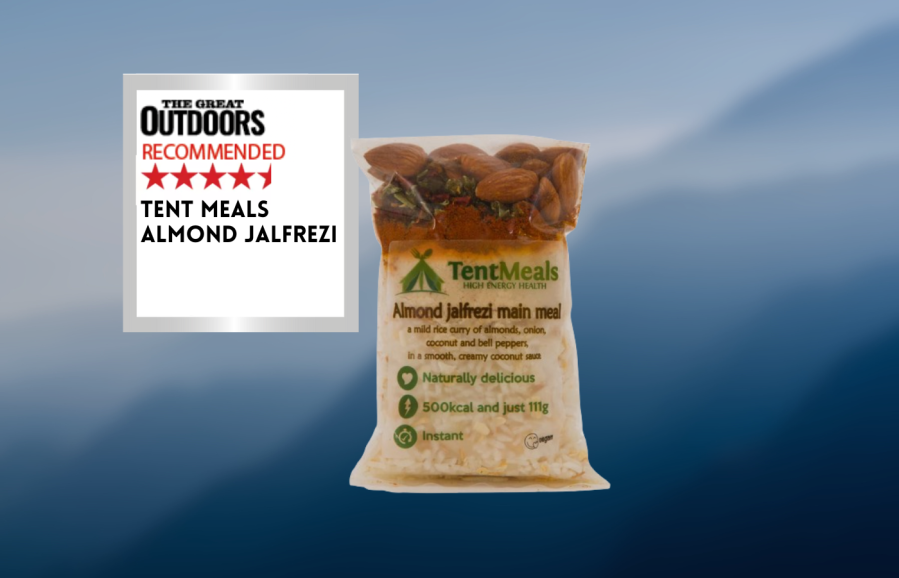
The Tent Mealls Almond Jalfrezi is the only meal tested in our guide to Best backpacking meals for 2024 that does not come in a pouch that can be used to rehydrate the meal. This means that you need to do it yourself, in a pan or other reusable container. Although this is a downside, there are benefits: only 4g of plastic packaging are used per meal, and the packaging is fully recyclable (most brands used foil-coated packaging that is not recyclable). Another benefit is that you can fit more meals in your pack.
Alex Roddie Recommends
It’s a very mild curry – which was great for my taste, but (according to my fledgling curry knowledge) jalfrezi tends to be hotter than this. So it may disappoint if you are looking for something hot- Excellent value
- High in protein
- Quality ingredients
- Need a pan to prepare
- Unusually mild for a Jalfrezi
| Quick specs | |
|---|---|
| Price: £5.50 Weight: 178g Calories: 500 Calories/100g: 280.9 Calories/£1: 90.9 Time to hydrate: 10 minutes Vegan/vegetarian/dairy free/gluten free? vegan Allergens: almonds, coconut basecampfood.com |
Value is good with the Tent Meals Almond Jalfrezi, and the meal is packed with high-quality natural ingredients, including whole almonds and delicious coconut. It hydrated correctly in the advised time of 10 minutes, but didn’t need quite as much water as stated.
It’s a very mild curry – which was great for my taste, but (according to my fledgling curry knowledge) jalfrezi tends to be hotter than this. So it may disappoint if you are looking for something blazing hot.
800 Kcal versions of TentMeals products are also available, and at only £6.50 value is even better. Recommended.
Read more from Alex in his full Tent Meals Almond Jalfrezi Review
Adventure Menu Chicken Tikka Masala
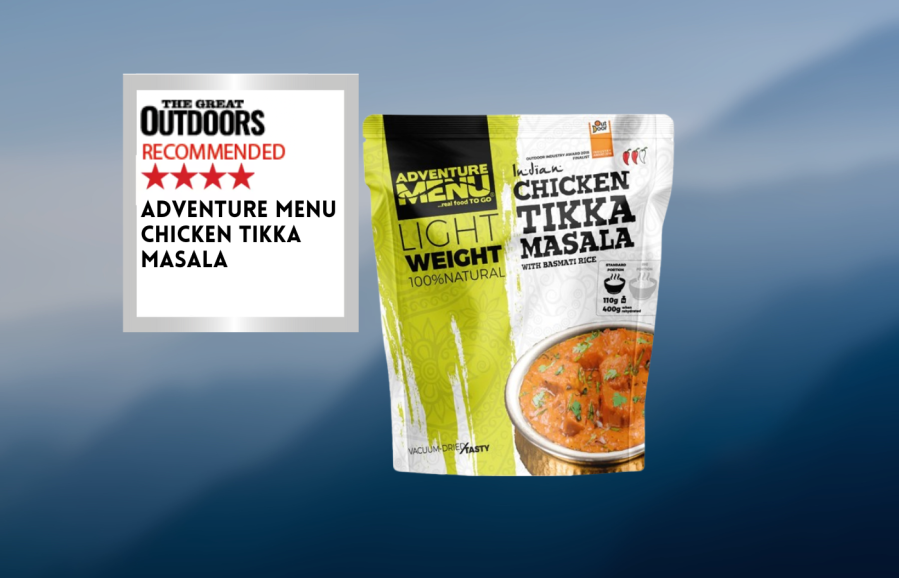
The Adventure Menu Chicken Tikka Masala is another vacuum-packed freeze-dried backpacking meal, with the benefits of reduced pack space and no oxygen absorber. One downside: the pack was hard to open. I needed to use my pocket knife to get in. There is a usable internal fill scale.
Alex Roddie Recommends
As chicken tikka masala goes this was one of the best I’ve eaten in dehydrated form.- Large pieces of chicken
- Good spice flavour
- High in saturated fat
- Pack not the easiest to open
| Quick specs | |
|---|---|
| Price: £10.99 Weight: 115g Calories: 760 Calories/100g: 660.9 Calories/£1: 69.2 Time to hydrate: 9 minutes Vegan/vegetarian/dairy free/gluten free? no Allergens: cream, milk basecampfood.com |
The ingredients in the Adventure Menu Chicken Tikka Masala do appear to be mostly or entirely natural – but the meal is high in saturated fat (most likely from the cream), and has more salt than some meals.
The meal rehydrated in nine minutes, right on schedule. You get really large lumps of chicken in this one – so big you’ll need to take several bites! This is a world away from typical old-school dehydrated meals where everything is chopped into fine chunks, and can make a big difference to your experience of the meal. As chicken tikka masala goes this was one of the best I’ve eaten in dehydrated form.
Although the sticker price is high, value is reasonable (by 2024 standards) considering the calories and quality.
Expedition Foods Vegetable Stir Fry
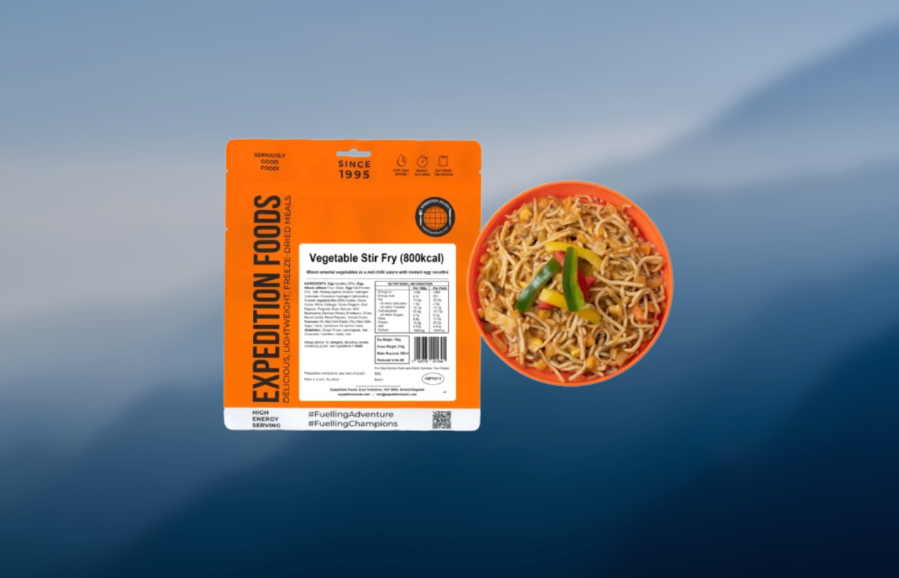
Expedition Foods stock a vast range of different backpacking meals – and in 450, 800 or 1,000 Kcal packs. I tend to find 450 a bit small, but 800 is just right, especially in winter where you’re burning more energy.
Alex Roddie’s verdict
Recent price rises have made this meal poorer value than it used to be. However, it still represents decent value compared to the other meals tested.- Satisfying and moreish
- Needed more time and water to hydrate than claimed
| Quick specs | |
|---|---|
| Price: £10.49 Weight: 194g Calories: 800 Calories/100g: 412.4 Calories/£1: 76.3 Time to hydrate: 7 minutes Vegan/vegetarian/dairy free/gluten free? vegetarian, dairy free Allergens: egg, wheat, sulphites expeditionfoods.com |
The egg noodles within the Expedition Foods Vegetable Stir Fry were very good, and to add to the varied textures there are bean sprouts, red peppers, sweetcorn, and carrots. This is a carby meal; I found it very satisfying after a hard day on the hill and could honestly have polished off a 1,000 Kcal portion.
One downside to the Expedition Foods Vegetable Stir Fry came in preparation. After adding the specified amount of water and waiting the specified time, the meal was still a bit crunchy and clearly needed more water. I ended up adding about 200ml and waiting a couple of minutes longer.
Recent price rises have made this meal poorer value than it used to be. However, it still represents decent value compared to the other meals tested.
Read more from Alex in his full Expedition Foods Vegetable Stir Fry Review
Firepot Mac ‘n’ Greens
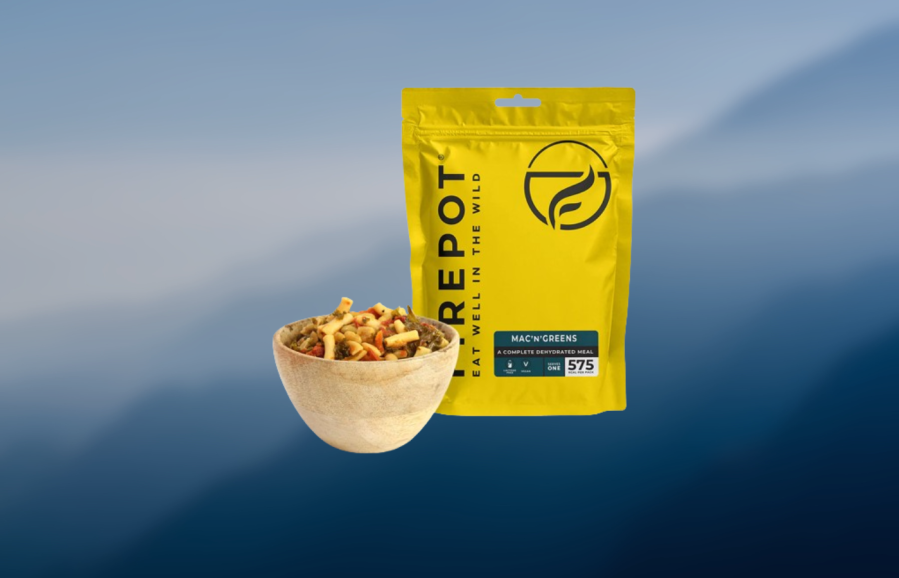
If you’re on a long trip and craving some greens rather than the usual cheesy macaroni then the Firepot Mac ‘n’ Greens is a top backpacking meal option to look at.
Firepot meals emphasise absolutely top-quality ingredients, as all meals are cooked by hand using fresh ingredients and then dehydrated. I particularly enjoyed the generous helpings of kale within the Firepot Mac ‘n’ Greens. One downside: for my taste there was a bit too much garlic.
Alex Roddie’s verdict
If you’re on a long trip and craving some greens rather than the usual cheesy macaroni, this is a top option to look at.- Quality ingredients
- Satisfying veg
- Too much garlic
- Long rehydration time
| Quick specs | |
|---|---|
| Price: £8.49 Weight: 135g Calories: 575 Calories/100g: 425.9 Calories/£1: 67.7 Time to hydrate: 15 minutes Vegan/vegetarian/dairy free/gluten free? vegan, dairy free Allergens: wheat, celery firepotfood.com |
Firepot meals have longer rehydration times than other brands. However, the quoted rehydration time tends to be accurate. Firepot says wait for 15 minutes, and after 15 minutes your meal is done. No prodding with a spoon, deciding it’s still a bit crunchy, then sealing up again for another few minutes.
Firepot’s range is expanding and they have some unique recipes that other brands can’t match. I have also recently enjoyed their smoky tomato paella.
Read more from Alex in his full Firepot Mac ‘n’ Greens Review
REAL Turmat Taco Bowl

REAL Turmat backpacking meals are freeze-dried, which means that the ingredients retain their shape and structure better than other forms of dehydration. The end result: meals that taste a bit more like real meals, and often have better texture and mouthfeel. REAL Turmat’s taco bowl is a good example of this, as I often forgot that I was eating a dehydrated meal when enjoying it.
Alex Roddie’s Verdict
One thing REAL Turmat do that most other brands don’t: the packages are vacuum packed. This has two benefits. Pack size is smaller, and no oxygen absorber is needed.- Great flavour
- Creamy texture
- Additives
- Fewer calories than some options
- A little expensive
- High in salt
| Quick specs | |
|---|---|
| Price: £11.99 Weight: 128g Calories: 528 Calories/100g: 412.5 Calories/£1: 44.0 Time to hydrate: 8 minutes Vegan/vegetarian/dairy free/gluten free? dairy free Allergens: celery basecampfood.com |
The flavour and creamy texture were delicious. One thing to note is that the ingredients list contains far more additives and artificial ingredients than most of the other meals listed, including anticaking agents, antioxidants, and various E-numbers. It’s also rather high in salt, and you get fewer calories for your money than any other meal tested.
One thing REAL Turmat do that most other brands don’t: the packages are vacuum packed. This has two benefits. Pack size is smaller, and no oxygen absorber is needed.
Read more from Alex in his full REAL Turmat Taco Bowl Review
Torq Supercharged Chilli Non Carne
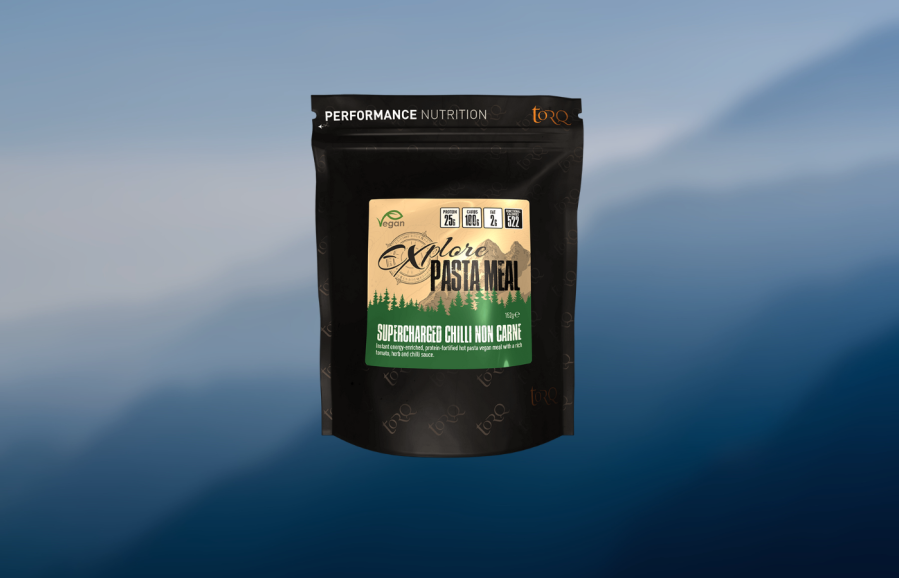
As you might expect from a fitness-oriented brand, the Torq Supercharged Chilli Non Carne backpacking meal is high in protein (thanks to the added pea protein). There is also added sugar and salt. However, the rest of the ingredients list looks pretty standard, with natural ingredients including mushrooms and sun-dried tomatoes. Although it’s a chilli meal, the carbs come from pasta instead of rice.
Alex Roddie’s Verdict
Overall, although this is from a fitness brand, this meal is worth a look for backpackers, especially if you’re looking for something with added protein- Filling and tasty
- High in protein
- No fill line
- Added sugar
| Quick specs | |
|---|---|
| Price: £8.95 Weight: 152g Calories: 522 Calories/100g: 343.4 Calories/£1: 58.3 Time to hydrate: 10 minutes Vegan/vegetarian/dairy free/gluten free? vegetarian Allergens: wheat basecampfood.com |
The Torq Supercharged Chilli Non Carne rehydrated in 10 minutes as advised. Texture was average at best, with very small pieces of vegetables, and there wasn’t too much chilli kick. However, it did taste good – quite moreish at the end of a hill day.
One downside is that there is no fill line on the packaging. It just says to add 350–400ml of water. This is fine if you have a pan with markings, but otherwise it’s a pain. Overall, although this is from a fitness brand, this meal is worth a look for backpackers, especially if you’re looking for something with added protein
Read Alex’s full Torq Supercharged Chilli Non Carne Review
Adventure Nutrition Chicken and Vegetable Pasta
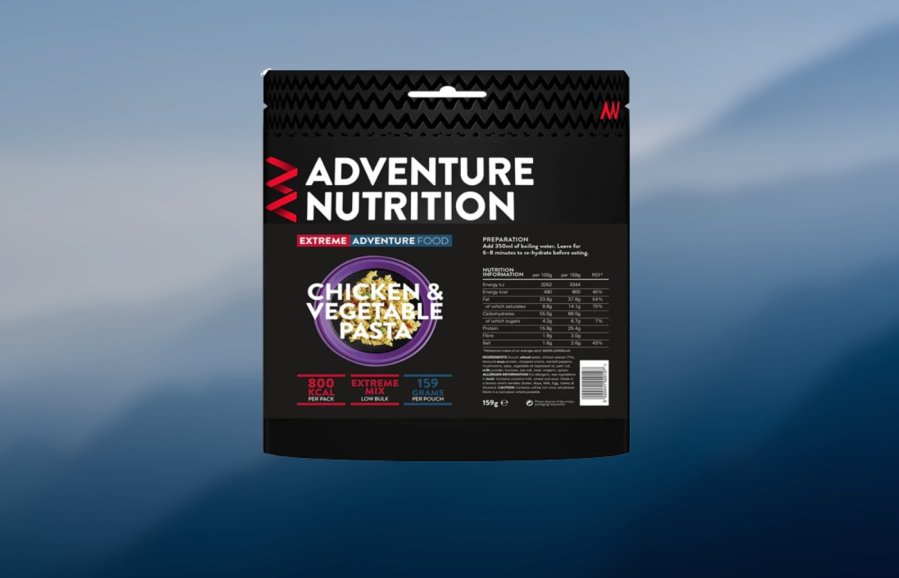
The packaging gains points here for very clear pictorial instructions, including an obvious fill scale marked in millilitres. There are added palm oil and rapeseed oil in the ingredients. You do get peas, onions, mushrooms, and red bell peppers along with your pasta, though – and it’s another meal with added protein, this time from soya.
Alex Roddie’s Verdict
I would have preferred larger chunks. I found it to be a tasty meal, although the sauce was slightly oily.- High in protein
- Great value
- Clear instructions
- Tastes good
- Contains palm oil
- Sauce a little oily
| Quick specs | |
|---|---|
| Price: £9.49 Weight: 159g Calories: 800 Calories/100g: 503.1 Calories/£1: 84.3 Time to hydrate: 7 minutes Vegan/vegetarian/dairy free/gluten free? no Allergens: milk, wheat, soya basecampfood.com |
The Adventure Nutrition Chicken and Vegetable Pasta rehydrated as advised in seven minutes. It’s another traditional dehydrated meal with finely chopped ingredients. Sadly this meant that the chicken pieces disappeared into the mix – I would have preferred larger chunks. I found it to be a tasty meal, although the sauce was slightly oily.
This meal is also available in 600 and 1,000 Kcal variants. Value is good – it’s one of the best-value meals tested.
Read Alex’s full Adventure Nutrition Chicken and Vegetable Pasta
Summit to Eat Beef and Potato Stew
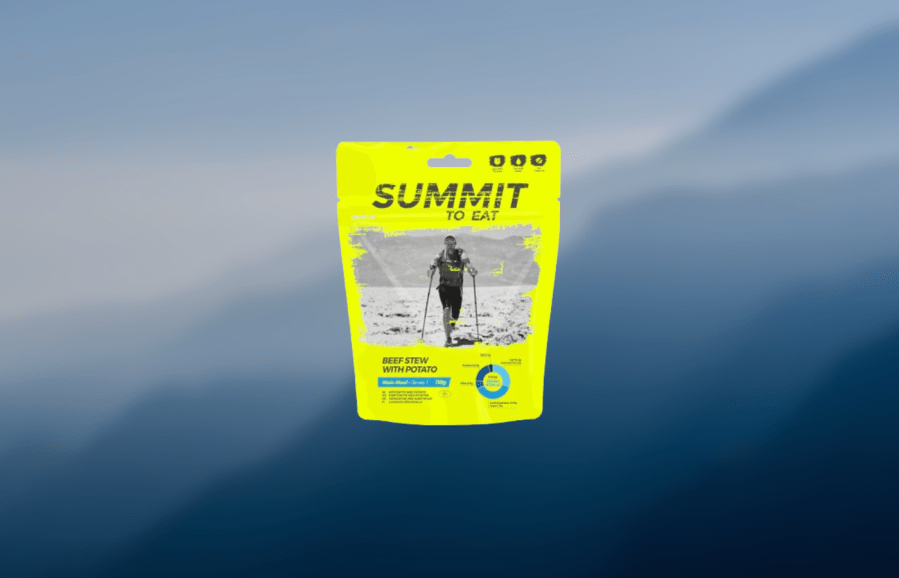
The packaging provides all of the essential information, including both a file line and fill volume in millilitres, although the instructions are tiny and hard to read. The ingredients list shows few obvious additives beyond rapeseed oil. However, there is added salt, and it’s also relatively high in sugar.
Alex Roddie’s verdict
Although the experience of eating this wasn’t as pleasant as the other meals tested, Summit to Eat is still worth considering for an affordable option.- Excellent value
- High in salt and sugar
- Tiny text on packaging
- Beef chewy
| Quick specs | |
|---|---|
| Price: £7.45 Weight: 118g Calories: 624 Calories/100g: 528.8 Calories/£1: 83.8 Time to hydrate: 9 minutes Vegan/vegetarian/dairy free/gluten free? no Allergens: none basecampfood.com |
The Summit to Eat Beef and Potato Stew took about a minute longer to rehydrate acceptably than the advised eight minutes, and even when hydrated I found the potato chunks rather chewy. The small beef strips remained very chewy for as long as it took to eat the meal. The rest of the ingredients were rather mushy and didn’t have much texture.
Although the experience of eating this wasn’t as pleasant as the other meals tested, Summit to Eat is still worth considering for an affordable option. Value is up there amongst the best tested, making it relatively painless on your wallet if you want to stock up on meals for a big trip.
What to look for in backpacking meals
How much does backpacking food cost?
With recent price rises, some meals are now £10.99–£11.99. This can add up, so if provisioning a long trip it’s worth looking at cheaper brands. More expensive meals are often made from higher-quality ingredients and have fewer additives.
Calories
You could be burning 2–3000 more calories on a long hill day than you would in everyday life, making high-energy food essential. Look for at least 500kcal in a meal – ideally more. In winter I prefer at least 800kcal. Some brands offer 1000kcal+ options.
Weight
Lighter is better, but only if the food gives you enough energy. This is why it’s useful to know how many Calories/100g the food offers.
Taste and texture
Variety is a spice of backpacking life – old favourites can become tiresome if you have no options. Better-quality grub tend to have more flavour and texture, meaning it’s more like
a real meal.
Ingredients
Some products will contain palm oil or artificial additives and preservatives; other brands make a point of avoiding these, focusing on nutrition and quality natural ingredients.
Dietary requirements
Many vegan, vegetarian, lactose-free and gluten-free meals are available. This is usually clearly marked on the packet, along with any allergens.
Method of preservation
Meals are either freeze-dried or dehydrated after cooking. Opinions vary on which leads to better preservation of texture and flavour, but both will remove 100% of the water, reducing bulk and weight.
Ease of preparation
You’ll need to add boiling water and leave the meal to hydrate. A good product will tell you how much water to add, and a shorter rehydration time means less time waiting hungry. A well-designed pack is easy to open and easy to reseal whilst you wait.





